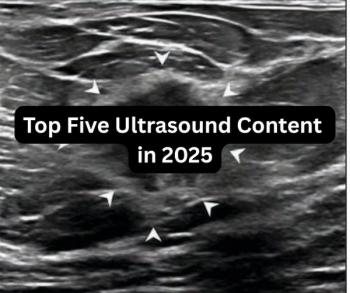
Cone-Beam CT Best for Visualizing Hard-Contrast Objects
Cone-beam CT is preferential to multislice spiral CT for hard-contrast objects, study says.
There was not that great a difference between cone-beam computed tomography (CBCT) and multislice spiral computed tomography (MSCT) with respect to dose and image quality, according to the results of a study published recently in
These results were taken from a study by Alexander A. Schegerer, PhD, of the department of medical and occupational radiation protection, Federal Office for Radiation Protection, Neuherberg, and colleagues who compared patient exposure and image quality of various CBCT and MSCT protocols for abdominal and genitourinary imaging.
According to Schegerer, the application of CBCT for image-guided interventions outside the radiology department has strongly increased.
“Cone-beam computed tomography has been established in many different clinical fields, for example, neurology, otolaryngology, cardiology, abdominal angiography, musculoskeletal imaging, and, urology,” Schegerer said. “To date, there are only few reports in the literature on radiation doses and image quality for CBCT.”
Schegerer and colleagues examined the CBCT and MSCT protocols for imaging soft tissue and hard-contrast objects at varying dose levels.
CBCT protocols had an effective radiation dose that ranged between 0.35 mSv to 18.1 mSv, with the local skin dose reaching doses as high as 190 mGy.
“The effective dose necessary to realize the same contrast-to-noise ratio with CBCT and MSCT depended on the MSCT convolution kernel: the MSCT dose was smaller than the corresponding CBCT dose for a soft kernel but higher than that for a hard kernel,” Schegerer said.
The researchers also compared noise-power spectrum of the two protocols and found that the spectrum of images taken with CBCT at tube voltages of 85/90 kV(p) were at least half of that of images measured at 103/11 kV(p) at any chosen spiral frequency.
“As compared with MSCT using a medium-hard convolution kernel, CBCT produces images at medium noise levels and, simultaneously, medium spatial resolution at approximately the same dose,” Schegerer said. “It is well suited for visualizing hard-contrast objects in the abdomen with relatively low image noise and patient dose.”
He added that for the detection of low-contrast objects at standard tube voltages of approximately 120 kV(p), however, MSCT should be preferred.
Finally, the researchers noted that it is indispensable to carefully justify and optimize the CBCT protocols predefined by the manufacturer to the specific clinical needs of different types of examinations. The collimation of the radiation field has to be adapted to the clinically relevant body region to reduce patient exposure.
Newsletter
Stay at the forefront of radiology with the Diagnostic Imaging newsletter, delivering the latest news, clinical insights, and imaging advancements for today’s radiologists.




























